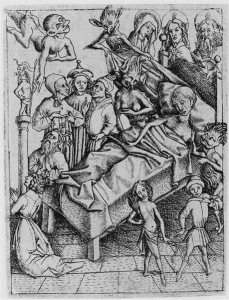By Elizabeth A. Lehfeldt
“The contagious pestilence, which is now spreading everywhere, has left many parish churches and other benefices in our diocese without an incumbent, so that their inhabitants are bereft of a priest…we understand that many people are dying without the sacrament of penance because they do not know what they ought to do in such an emergency…if when on the point of death they cannot secure the services of a properly ordained priest, they should make confession of their sins…to any lay person, even to a woman, if a man is not present.”*
 This oft-cited passage speaks volumes about the devastation wrought by Bubonic plague in the late Middle Ages. Medieval Christians, deeply concerned about questions of salvation, believed it absolutely necessary to make a final confession before their death. Yet the swift death (most of the visibly infected who succumbed did not live longer than a week) at the hands of the disease and the overwhelming mortality rates confounded the ability of priests to hear so many confessions. Medieval Europeans understood the moment of death as a vulnerable moment (well-illustrated by the image reproduced here), when demons might tempt the soul of the dying. And so, the Bishop of Bath and Wells bent the rules in a rather astounding fashion. First, he allowed that laypeople could perform this sacrament. This alone was an amazing inversion of medieval hierarchies that invested priests alone with this authority. But then the bishop, in a move that must have produced gasps throughout the sanctuaries of his diocese (priests would have been instructed to read his admonitions aloud), extended that same power to laywomen. The salvation of souls, at least in this instance, trumped any misgivings about the gender of the person exercising this authority.
This oft-cited passage speaks volumes about the devastation wrought by Bubonic plague in the late Middle Ages. Medieval Christians, deeply concerned about questions of salvation, believed it absolutely necessary to make a final confession before their death. Yet the swift death (most of the visibly infected who succumbed did not live longer than a week) at the hands of the disease and the overwhelming mortality rates confounded the ability of priests to hear so many confessions. Medieval Europeans understood the moment of death as a vulnerable moment (well-illustrated by the image reproduced here), when demons might tempt the soul of the dying. And so, the Bishop of Bath and Wells bent the rules in a rather astounding fashion. First, he allowed that laypeople could perform this sacrament. This alone was an amazing inversion of medieval hierarchies that invested priests alone with this authority. But then the bishop, in a move that must have produced gasps throughout the sanctuaries of his diocese (priests would have been instructed to read his admonitions aloud), extended that same power to laywomen. The salvation of souls, at least in this instance, trumped any misgivings about the gender of the person exercising this authority.
Yet this was not the only instance in premodern times of women being entrusted with sacramental responsibility. Evidence from Germany and England also reveals that midwives were allowed to perform emergency baptisms. Worried that vulnerable newborn infants might die before the priest could arrive, civic and ecclesiastical authorities admitted that it was worth jettisoning the rules in order to secure the salvation of these newly-arrived souls. Once again, salvation trumped gender.
Significantly, what links these exceptions to the rule is the specter of death. The presence of women at the moment of possible death from a terrifying disease or at the precarious moment of an infant’s birth created exceptional circumstances that invested them with unusual power and authority.
* Ralph of Shrewsbury, Bishop of Bath and Wells, writing in 1349. Reproduced in Rosemary Horrox, The Black Death (Manchester, 1994), 271-3.
Elizabeth A. Lehfeldt is Professor of History at Cleveland State University. She regularly teaches a course on the history of Bubonic plague and writes on the history of gender in Europe between 1400 and 1700.
